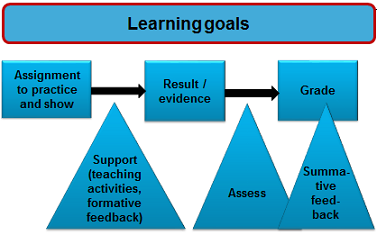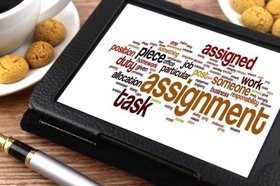What to consider when using assignments as an assessment method for a course?
An assignment is a piece of (academic) work or task. It provides opportunity for students to learn, practice and demonstrate they have achieved the learning goals. It provides the evidence for the teacher that the students have achieved the goals. The output can be judged using sensory perception (observing, reading, tasting etc.). The assignment can focus on a product as output (e.g. research report, design, prototype, etc.) and/or a process (e.g. research process, group process) and/or the performance of individual skills or competences (e.g. professional skills, communications skills).
 There are a lot of benefits to gain from using an assignment as an assessment method. Assignments can for instance be used to test higher cognitive abilities and the application of specific skills or knowledge. It can mirror the future professional practice. It can be used to assess the integration of knowledge, skills and attitudes (competences).
There are a lot of benefits to gain from using an assignment as an assessment method. Assignments can for instance be used to test higher cognitive abilities and the application of specific skills or knowledge. It can mirror the future professional practice. It can be used to assess the integration of knowledge, skills and attitudes (competences).
When designing and using an assignment as a summative test (students get a score or grade or pass/fail judgment), there are things to consider: will it be an individual assignment or group assignment; just one assignment or more; how to make it motivating and challenging; will I provide interim feedback etc.? There are also issues to consider for assessing the final results. Like: how to assess in a reliable, objective, consistent way; what are the criteria to be used; how to weight different elements of the assignment; how to calculate the grades based on the scores; how to avoid or check for free-riding or plagiarism etc.
When assessing with assignments, we should pay attention to:
>> validity: we really test what we want to test; the assignment and the way we assess the results are aligned with the learning goals.
>> reliability: based on the results, we make a right, just, fair, objective distinction between pass/fail or provide the just grade. Our scoring or grading is done in a consistent way and the judgments or the grades are meaningful.
>> transparency: it clear upfront for the students what they will learn, what they have to do (as evidence; what to deliver or show), how they will be assessed and what to expect during the process.
>> the assignment and the feedback provided will support the learning process.
With the toolbox below, related to the questions and issues mentioned above, we hope to offer you useful tips and guidelines for designing and assessing assignments.
Designing assignments for assessment  What should you consider when designing an assignment you want to use for assessment purpose? How to make sure your assignment will be aligned with your learning goals and teaching process?
What should you consider when designing an assignment you want to use for assessment purpose? How to make sure your assignment will be aligned with your learning goals and teaching process?
How to assess: criteria and rubrics  Learning goals can be broad or ambiguous. Clearly defined criteria help to define and explain for the students what is valued. Criteria help students to feel more confident about what is expected. It will help you, as the examiner, to assess in a consistent and objective way and it will help to make the feedback specific. Scores and grades will be based on the criteria.
Learning goals can be broad or ambiguous. Clearly defined criteria help to define and explain for the students what is valued. Criteria help students to feel more confident about what is expected. It will help you, as the examiner, to assess in a consistent and objective way and it will help to make the feedback specific. Scores and grades will be based on the criteria.
A criteria-(check)list identifies key aspects of performance or of the intended outcome. Useful resources to learn more about how to define criteria, are:
A rubric is more elaborate; it shows also the levels or standards of performance.
Useful resources to learn more about rubrics, to find templates or examples:
Efficient grading (when dealing with large groups and extensive work) The disadvantage of assignments is, most of the time, that scoring and grading will take a lot of time. Especially if you want to give the students detailed feedback. The resources below may give you some (new) ideas and tips to assess and provide feedback in an efficient as well as an effective way.
How to give feedback with impact  How to provide feedback with impact? How to stimulate students to use the feedback (on essays)? How to help them to prepare for success (feed forward)? Five useful resources from the Learnhigher site (UK):
How to provide feedback with impact? How to stimulate students to use the feedback (on essays)? How to help them to prepare for success (feed forward)? Five useful resources from the Learnhigher site (UK):
1) Top 10 tips on Assessment for Learning. This resource provides a set of tips highlighting the importance of feedback and assessments, and how these can be best utilised in order to enhance and encourage learning.
2) Slides you can use to help your students realize the importance and purpose of feedback: Using essay feedback to improve performance. (Unit for the Enhancement of Learning and Teaching. University of Kent).
3) Tips for students on achieving the best possible marks in assessments. Tips include understanding the question or brief, practicality, an awareness of assessment criteria, planning and use previous feedback. Assessment: step by step. (Learning Higher website).
4) Learning from your assessment feedback. This resource offers advice for students on how they may make the most out of any comments (intermediate feedback) received.
5) Feedback and reflection in group work. Tips for students involved in group work to learn how to provide and receive useful and constructive feedback.
Group work: how to design and assess?  Resources:
Resources:
How to avoid and detect fraud, plagiarism and free-riding Academic integrity is important and most students will agree and act accordingly. But nevertheless fraud occurs occasionally and as an examiner you are expected to detect fraud, whether it is real cheating, like delivering work someone else made, or plagiarism or free-riding. But how can you detect it? And what to do next?
In case of plagiarism or free-riding, it might not always happen with the wrong intentions or circumstances may have influenced what happened. Better to look for ways to prevent it, but what can be done?
Below you will find some useful resources dealing with these issues.
NB. Specific rules and regulations may apply for your educational programme. For the University of Twente you have to check the Educational Examination Rules (EER) for your own educational programme and the Rules & Regulations of the Examination Board for your programme or faculty. Be aware that you have to report fraud to the Examination Board!
The Chocolate Chip Cookie exercise - To think about assignments as assessment method  This Chocolate Chip Cookie exercise is used in de CELT course Testing & assessment. By providing answers for all the questions and sub-exercises, you practice the steps that will be relevant when you use an assignment to assess students' knowledge and skills. The topic seems easy, but after all it turns out that even for 'cookies' it is difficult enough to find suitable criteria and construct a rubric.
This Chocolate Chip Cookie exercise is used in de CELT course Testing & assessment. By providing answers for all the questions and sub-exercises, you practice the steps that will be relevant when you use an assignment to assess students' knowledge and skills. The topic seems easy, but after all it turns out that even for 'cookies' it is difficult enough to find suitable criteria and construct a rubric.
To download the CCC-exercise, click [here].
This exercise is especially developed for the course Testing & Assessment. This course is offered by the Centre of Expertise in Learning and Teaching (CELT), University of Twente. The course is part of the UTQ (BKO) and UEQ (BKE) trajectory. Copyright CELT-UT / Expertise team T&A. The material may be used by other parties provided that reference is made.
If you would like us to give a workshop on this subject, either in English or Dutch, face-to-face or online, please contact us: w.d.j.vlas@utwente.nl
 There are a lot of benefits to gain from using an assignment as an assessment method. Assignments can for instance be used to test higher cognitive abilities and the application of specific skills or knowledge. It can mirror the future professional practice. It can be used to assess the integration of knowledge, skills and attitudes (competences).
There are a lot of benefits to gain from using an assignment as an assessment method. Assignments can for instance be used to test higher cognitive abilities and the application of specific skills or knowledge. It can mirror the future professional practice. It can be used to assess the integration of knowledge, skills and attitudes (competences). 
 What should you consider when designing an assignment you want to use for assessment purpose? How to make sure your assignment will be aligned with your learning goals and teaching process?
What should you consider when designing an assignment you want to use for assessment purpose? How to make sure your assignment will be aligned with your learning goals and teaching process?  Learning goals can be broad or ambiguous. Clearly defined criteria help to define and explain for the students what is valued. Criteria help students to feel more confident about what is expected. It will help you, as the examiner, to assess in a consistent and objective way and it will help to make the feedback specific. Scores and grades will be based on the criteria.
Learning goals can be broad or ambiguous. Clearly defined criteria help to define and explain for the students what is valued. Criteria help students to feel more confident about what is expected. It will help you, as the examiner, to assess in a consistent and objective way and it will help to make the feedback specific. Scores and grades will be based on the criteria.
 How to provide feedback with impact? How to stimulate students to use the feedback (on essays)? How to help them to prepare for success (feed forward)? Five useful resources from the Learnhigher site (UK):
How to provide feedback with impact? How to stimulate students to use the feedback (on essays)? How to help them to prepare for success (feed forward)? Five useful resources from the Learnhigher site (UK): Resources:
Resources:  This Chocolate Chip Cookie exercise is used in de CELT course Testing & assessment. By providing answers for all the questions and sub-exercises, you practice the steps that will be relevant when you use an assignment to assess students' knowledge and skills. The topic seems easy, but after all it turns out that even for 'cookies' it is difficult enough to find suitable criteria and construct a rubric.
This Chocolate Chip Cookie exercise is used in de CELT course Testing & assessment. By providing answers for all the questions and sub-exercises, you practice the steps that will be relevant when you use an assignment to assess students' knowledge and skills. The topic seems easy, but after all it turns out that even for 'cookies' it is difficult enough to find suitable criteria and construct a rubric.